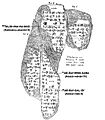Shalmaneser II facts for kids
Quick facts for kids Shalmaneser II |
|
|---|---|
| King of Assyria | |
| King of the Middle Assyrian Empire | |
| Reign | 1031–1019 BC |
| Predecessor | Ashurnasirpal I |
| Successor | Ashur-nirari IV |
| Issue | Ashur-nirari IV |
| Father | Ashurnasirpal I |
Shalmaneser II was a king of Assyria. His name, Salmānu-ašarēd II, means "Being peaceful is foremost." He ruled from 1030 to 1019 BC. He was the 93rd king listed on an important ancient document called the Khorsabad copy of the Assyrian Kinglist.
Life as King
Shalmaneser II became king after his father, Ashurnasirpal I. He ruled for 12 years. We know this from ancient records, including a damaged list of officials called an eponym list. These lists helped ancient Assyrians keep track of years.
During his time, Assyria faced many challenges. There were droughts and problems with crops. New groups of people, called Arameans, were moving into the area. This was likely due to changes in the climate.
Battles and Challenges
Shalmaneser II had to deal with these Arameans. They caused trouble and took over some Assyrian lands. A later king, Ashur-dan II, wrote about how Shalmaneser II lost land and people to these groups. It was a difficult time for the kingdom.
Another king, Ashurnasirpal II, also mentioned Shalmaneser II. He wrote about taking back cities that Shalmaneser II had tried to protect. These cities were important forts against the land of Nairi. The Arameans had captured them.
What We Know About His Reign
It can be tricky for historians to be sure which ancient writings belong to Shalmaneser II. This is because other kings had similar names. However, some important discoveries are definitely about him.
One is a large stone pillar, or stele, found in the city of Aššur. It lists his family tree. It says: "Shalmaneser, great king, king of the universe, king of Assyria, son of Ashurnasirpal I, king of Assyria, son of Shamshi-Adad IV, who was also king of Assyria."
Another record shows that he gave special cedar oil to the main temple of Aššur. He also gave perfumes to Idiglat, who was the god of the Tigris river. There is also a long message written to the goddess Ishtar for a temple opening, which might be from him. Some gold and silver disks with the name "Shalmaneser" could also be from his time.
Shalmaneser II was followed by his son, Ashur-nirari IV, who ruled for a short time. Then, his brother, Ashur-rabi II, became king.
See also
 In Spanish: Salmanasar II para niños
In Spanish: Salmanasar II para niños
Images for kids


